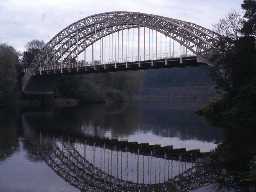Local History
Wylam (Northumberland)
Wylam is a small parish in the Tyne valley bordering Tyne and Wear. It rises from the banks of the River Tyne to moderately high land near the A69 Newcastle to Carlisle road. Although it may be small Wylam has two river crossings and a wealth of post-medieval remains of importance not just to the parish ' but the world.
Although the Tyne valley was probably attractive land for early prehistoric hunter-gatherers and settlers no traces have yet been discovered here. Similarly, no Iron Age settlement is known here, but a nearby hillfort in Horsley Wood would have overlooked part of the parish.
Wylam lies south of Hadrian's Wall but no Roman remains have been found in the parish. Likewise, no early medieval presence is known, despite the numerous Anglo-Saxon sites along the Tyne valley at Ovingham, Bywell and within Tyne and Wear at Newburn.
Later, in the medieval period, Wylam was an estate of Tynemouth Priory (Tyne and Wear). The priory owned land and the services of tenants around the area through monastic granges. Wylam Hall was the base of this small estate and, like Tynemouth Priory, needed fortification against Scottish raiders.
Wylam seems to have been a focus for innovation in the post-medieval period. There used to be many remains associated with the coal industry, including many collieries, fire clay works and waggonways. Such operations needed many workers and included the family of the great engineer George Stephenson who lived in only one room of the house now known as George Stephenson's Cottage. As part of the Industrial Revolution others made huge sums of money on Tyneside, including Charles Parson, inventor of the turbine, who lived at Holeyn Hall. Another inventor, who lived at Wylam Hall, was William Hedley who experimented with steam engines and built Puffing Billy and Wylam Dilly at Wylam Forge with Timothy Hackworth and John Foster. Transport links were developed from the purely industrial enterprises of waggonways through the Newcastle and Carlisle Railway. Wylam station is one of the oldest stations in the world still in passenger use. Two bridges cross the River Tyne at Wylam: one a road bridge that started life as a combined road and rail bridge connecting the village with its collieries on the south bank; and the other, the West Wylam Railway Bridge a precursor of the famous Tyne Bridge in Newcastle. In modern times, the importance of river crossings so near to Newcastle resulted in the construction of a pillbox outside the village during World War II (1939-1945).
Wylam is now a small exclusive parish. It has lost the industry that for so long characterised it to the world. The parish is beyond urban Tyneside and has managed to regain some peace and quiet from an industrialised past.
Although the Tyne valley was probably attractive land for early prehistoric hunter-gatherers and settlers no traces have yet been discovered here. Similarly, no Iron Age settlement is known here, but a nearby hillfort in Horsley Wood would have overlooked part of the parish.
Wylam lies south of Hadrian's Wall but no Roman remains have been found in the parish. Likewise, no early medieval presence is known, despite the numerous Anglo-Saxon sites along the Tyne valley at Ovingham, Bywell and within Tyne and Wear at Newburn.
Later, in the medieval period, Wylam was an estate of Tynemouth Priory (Tyne and Wear). The priory owned land and the services of tenants around the area through monastic granges. Wylam Hall was the base of this small estate and, like Tynemouth Priory, needed fortification against Scottish raiders.
Wylam seems to have been a focus for innovation in the post-medieval period. There used to be many remains associated with the coal industry, including many collieries, fire clay works and waggonways. Such operations needed many workers and included the family of the great engineer George Stephenson who lived in only one room of the house now known as George Stephenson's Cottage. As part of the Industrial Revolution others made huge sums of money on Tyneside, including Charles Parson, inventor of the turbine, who lived at Holeyn Hall. Another inventor, who lived at Wylam Hall, was William Hedley who experimented with steam engines and built Puffing Billy and Wylam Dilly at Wylam Forge with Timothy Hackworth and John Foster. Transport links were developed from the purely industrial enterprises of waggonways through the Newcastle and Carlisle Railway. Wylam station is one of the oldest stations in the world still in passenger use. Two bridges cross the River Tyne at Wylam: one a road bridge that started life as a combined road and rail bridge connecting the village with its collieries on the south bank; and the other, the West Wylam Railway Bridge a precursor of the famous Tyne Bridge in Newcastle. In modern times, the importance of river crossings so near to Newcastle resulted in the construction of a pillbox outside the village during World War II (1939-1945).
Wylam is now a small exclusive parish. It has lost the industry that for so long characterised it to the world. The parish is beyond urban Tyneside and has managed to regain some peace and quiet from an industrialised past.
N13801
UNCERTAIN
Disclaimer -
Please note that this information has been compiled from a number of different sources. Durham County Council and Northumberland County Council can accept no responsibility for any inaccuracy contained therein. If you wish to use/copy any of the images, please ensure that you read the Copyright information provided.
